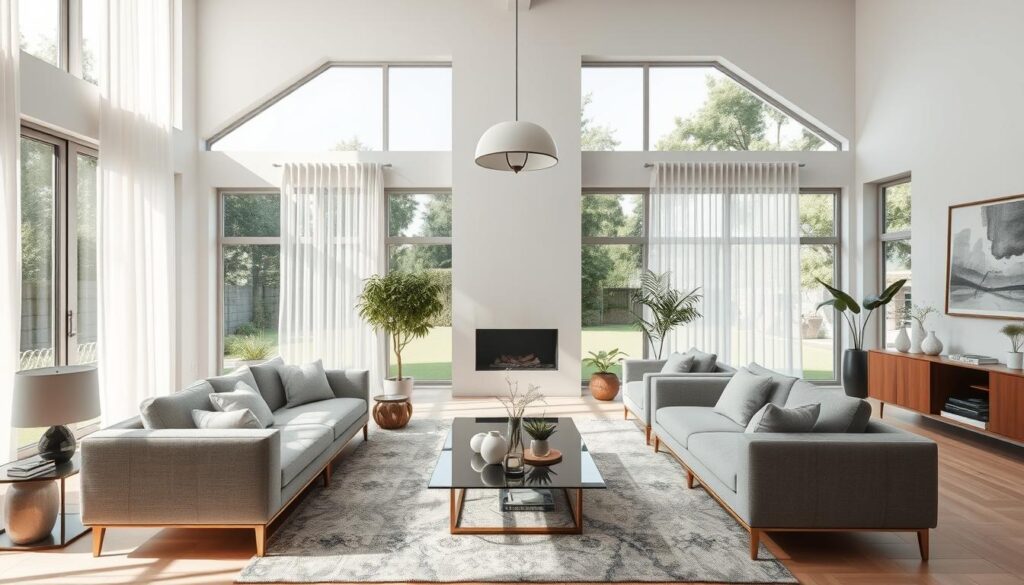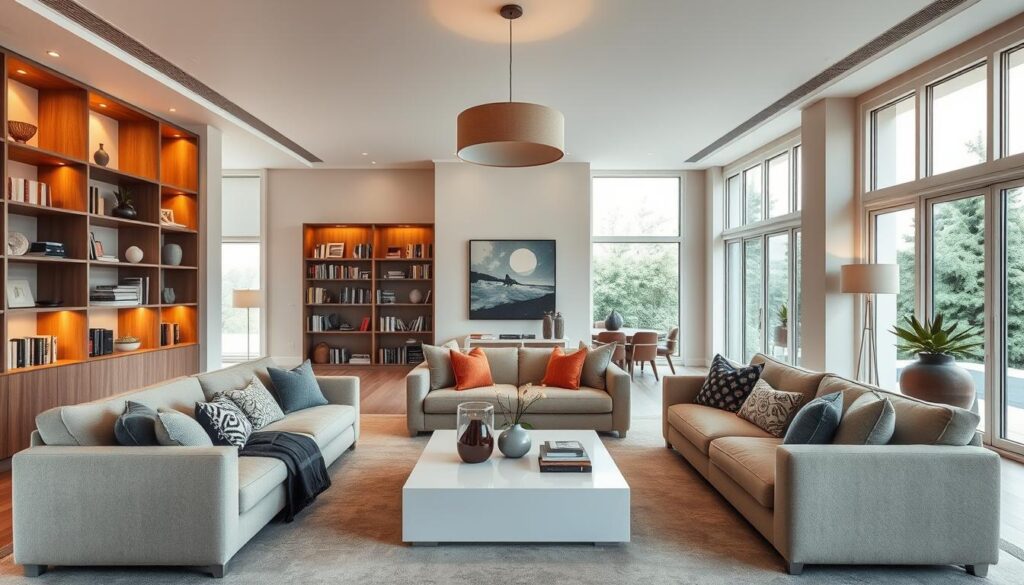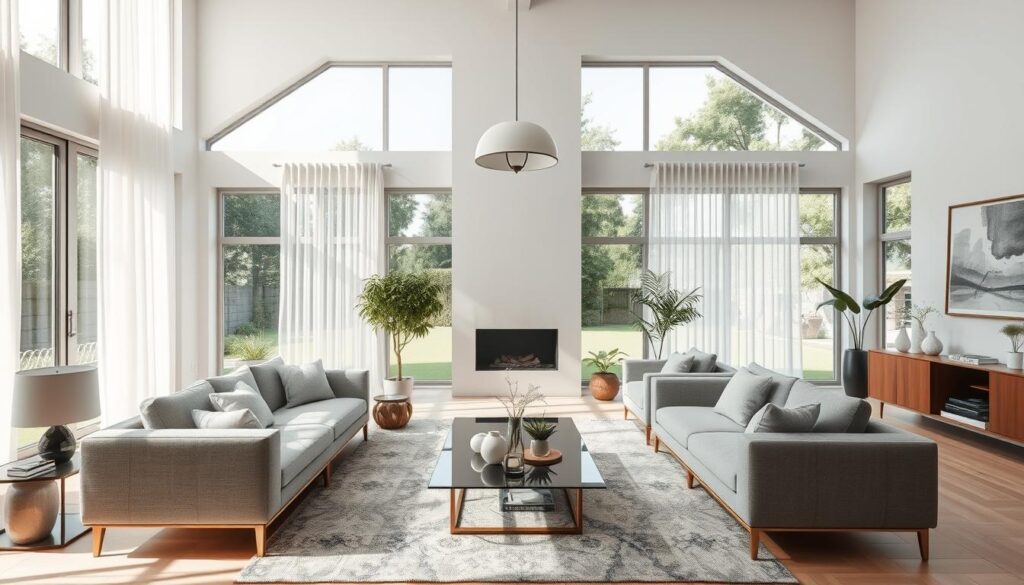Imagine stepping into a beautifully renovated space that perfectly reflects your personality and style. A well-planned Interior Remodeling Home Transformation project can turn your house into a dream home, enhancing both its aesthetic appeal and functionality.

Whether you’re looking to update a single room or undertake a comprehensive home transformation, the process can be both exciting and overwhelming. With the right guidance, you can navigate the journey of home renovation with confidence, creating a haven that you and your family will love.
Key Takeaways
- Understand the benefits of interior remodeling for enhancing your living space.
- Learn how to plan a successful home transformation project.
- Discover the importance of functionality in home renovation.
- Get insights into creating a beautiful and functional home.
- Find out how to navigate the home renovation process with confidence.
The Power of Thoughtful Home Design
Thoughtful home design is the cornerstone of creating a living space that truly reflects your personality and meets your needs. It’s about more than just aesthetics; it’s about crafting a home that enhances your lifestyle and provides a comfortable, functional space for living.
Identifying Your Lifestyle Needs and Preferences
To start, it’s crucial to identify your lifestyle needs and preferences. Consider how you use your space, your daily routines, and what features are essential to you. For instance, if you work from home, a dedicated office space might be a priority. Make a list of your needs and wants to guide your design decisions.
- Assess your daily routines and habits
- Consider the needs of all household members
- Think about your long-term plans and how they might impact your space
Evaluating Your Current Space’s Potential
Next, evaluate your current space’s potential. Look at the layout, natural lighting, and existing architectural features. Consider what works and what doesn’t, and think about how you can improve upon it. Take note of any structural elements that are worth preserving.

Creating a Vision for Your Ideal Living Environment
Finally, create a vision for your ideal living environment. Gather inspiration from various sources, such as design magazines, websites, or social media platforms. Develop a clear vision that incorporates your needs, preferences, and the potential of your space.
- Collect images and ideas that resonate with your vision
- Create a mood board or collage to visualize your design
- Consider consulting with a professional interior designer for expert guidance
By following these steps, you can harness the power of thoughtful home design to create a living space that is both beautiful and functional, tailored to your unique needs and preferences.
Interior Remodeling Home Transformation: A Comprehensive Approach
A comprehensive approach to Interior Remodeling Home Transformation involves understanding your needs, preferences, and the potential of your space. This foundational understanding is crucial for a successful home transformation.
Defining the Scope of Your Transformation
Defining the scope of your project is the first step in interior remodeling. It involves identifying the areas of your home that need renovation and determining the extent of the changes you wish to make. Consider creating a list of your priorities to help guide this process.
- Assess the current condition of your home.
- Identify your needs and wants for the renovation.
- Research different styles and trends for inspiration.
Balancing Aesthetics with Functionality
A successful home transformation balances aesthetics with functionality. This means selecting design elements that not only look great but also serve a practical purpose. For example, choosing multi-functional furniture can enhance the usability of your space.

Creating Cohesive Flow Between Spaces
To achieve a cohesive look throughout your home, consider the flow between different spaces. This can be accomplished by using a consistent design theme, color palette, or flooring material throughout your home, creating a sense of continuity and harmony.
By following these renovation tips and taking a comprehensive approach to your interior remodeling project, you can create a home that is both beautiful and functional.
Budgeting Wisely for Your Renovation Project
A well-planned budget is the backbone of any successful home renovation project. It not only helps in managing costs but also ensures that the project stays on track, meeting your expectations and needs.
Creating a Realistic Financial Plan
To create a realistic financial plan, start by assessing your financial situation and determining how much you can afford to spend on your renovation. Consider factors like savings, loans, and any other financial resources you might have. It’s also crucial to research the average costs of the renovations you have in mind to get a more accurate estimate.
Prioritizing Expenses for Maximum Impact
Prioritizing your expenses is vital to ensure that you allocate your budget to the most critical aspects of your renovation. Focus on the elements that will have the most significant impact on your home’s functionality and aesthetic appeal. For instance, if you’re renovating your kitchen, investing in quality cabinetry and countertops might be a priority.

Building in Contingency for Unexpected Costs
No matter how well you plan, unexpected costs can arise during a renovation project. It’s wise to build a contingency fund into your budget to cover any unforeseen expenses. A general rule of thumb is to allocate around 10-20% of your total budget for contingencies.
Tracking Expenses Throughout the Project
To stay within your budget, it’s essential to track your expenses throughout the renovation process. Keep a detailed record of all your expenditures, and regularly compare them against your budget. This will help you identify any areas where you might be overspending and make necessary adjustments.
By following these steps and maintaining a vigilant approach to your budget, you can ensure that your renovation project is completed successfully, within your financial means, and to your satisfaction.
Working with Professionals: Designers, Contractors, and Specialists
To achieve a seamless and stress-free renovation experience, it’s crucial to partner with skilled designers, contractors, and specialists. The right professionals can turn your vision into reality, ensuring that your home transformation is both beautiful and functional.
When to Hire Design Professionals
Design professionals can be invaluable when you’re looking to create a cohesive and stylish space. They bring expertise in understanding your needs, selecting materials, and overseeing the project. Consider hiring a designer when you’re unsure about the layout, want to incorporate complex design elements, or need help in choosing a color scheme and materials.
Finding and Vetting Qualified Contractors
Finding the right contractor is crucial for the success of your renovation project. Start by asking for referrals from friends, family, or online reviews. When vetting potential contractors, check their licenses, insurance, and past work. It’s also essential to get multiple bids and understand their workflow and communication style.
Establishing Clear Communication Channels
Clear communication is the backbone of any successful renovation project. Establishing open and transparent channels with your contractors and designers ensures that your needs are met and any issues are addressed promptly. Regular meetings and updates can help keep the project on track.
Understanding Contracts and Agreements
Before work begins, it’s vital to have a comprehensive contract in place. This document should outline the scope of work, timelines, payment schedules, and any warranties or guarantees. Understanding the terms of your contract can protect you from potential disputes and ensure a smooth renovation process.
| Professional | Role | Benefits |
|---|---|---|
| Designers | Create cohesive and stylish spaces | Bring expertise in material selection and design elements |
| Contractors | Oversee the renovation project | Ensure timely completion and quality workmanship |
| Specialists | Handle specific tasks like electrical or plumbing work | Provide specialized knowledge and skills |
By working with the right professionals and establishing clear communication and contracts, you can ensure a successful home renovation project that meets your needs and exceeds your expectations.
Kitchen Renovation: Creating the Heart of Your Home
Renovating your kitchen is more than just a cosmetic update; it’s about creating a space that resonates with your lifestyle. The kitchen is often considered the heart of the home, where meals are prepared, and memories are made. A well-designed kitchen renovation can significantly enhance the functionality and aesthetic appeal of this critical space.
Optimizing Layout for Functionality and Flow
A key aspect of kitchen renovation is optimizing the layout to improve functionality and flow. This involves considering the work triangle concept, which focuses on the relationship between the sink, stove, and refrigerator. By streamlining the workflow, homeowners can create a more efficient cooking environment. Careful planning is essential to ensure that the kitchen layout meets the needs of its users.
Selecting Cabinetry, Countertops, and Backsplashes
The selection of cabinetry, countertops, and backsplashes plays a crucial role in defining the kitchen’s style and durability. High-quality materials not only enhance the aesthetic appeal but also contribute to the longevity of the kitchen. From traditional wood cabinetry to modern quartz countertops, the choices are vast and varied. Homeowners should consider factors such as maintenance, sustainability, and budget when making their selections.
Incorporating Modern Appliances and Smart Technology
Modern appliances and smart technology are revolutionizing kitchen design. Integrating smart appliances that can be controlled via smartphones or voice commands adds a layer of convenience and innovation. When planning a kitchen renovation, it’s essential to consider how technology can enhance the cooking experience and improve overall functionality.
Lighting Strategies for Task and Ambiance
Effective lighting is critical in a kitchen, serving both practical and aesthetic purposes. A combination of task lighting (under-cabinet lighting, pendant lights) and ambient lighting (recessed lighting, chandeliers) can create a warm and inviting atmosphere. Layered lighting strategies can significantly enhance the kitchen’s functionality and ambiance, making it a more enjoyable space for cooking and socializing.
Bathroom Transformations: Blending Luxury with Practicality
With thoughtful planning, your bathroom can be transformed into a spa-like sanctuary that combines functionality with elegance. A well-designed bathroom not only enhances your daily routine but also significantly boosts your home’s value.
Space-Maximizing Layouts for Any Size
Maximizing space in your bathroom is crucial, regardless of its size. For smaller bathrooms, consider installing wall-mounted sinks and toilets to create a sense of openness. In larger bathrooms, you can incorporate freestanding tubs and separate shower areas to create distinct zones.
Selecting Durable and Water-Resistant Materials
Choosing the right materials is vital for a bathroom renovation. Opt for durable, water-resistant options such as porcelain tiles, granite countertops, and acrylic shower walls. These materials not only withstand moisture but also add a touch of luxury to your bathroom.
Creating Spa-Like Features and Experiences
To create a spa-like ambiance, consider incorporating features such as heated floors, rainfall showerheads, and freestanding tubs. Soft lighting and calming color schemes can also enhance the relaxing atmosphere of your bathroom.
Accessibility Considerations for All Ages
When designing your bathroom, it’s essential to consider accessibility features to ensure it’s usable for everyone. Installing grab bars, a curbless shower, and a raised toilet seat can make a significant difference. Additionally, consider a walk-in tub or a shower with a bench for added safety and comfort.
By blending luxury with practicality and considering the needs of all users, you can create a bathroom that is both beautiful and functional.
Living and Entertaining Spaces: Designing for Connection
A well-designed living space can transform the way we live and interact with others. It’s about creating an environment that is both beautiful and functional, fostering connection and community.
Furniture Arrangement for Conversation and Flow
The arrangement of furniture plays a crucial role in creating a welcoming atmosphere. To encourage conversation, furniture should be arranged in a way that creates intimate spaces within the larger room. Consider using circular or U-shaped configurations to facilitate interaction.
Moreover, ensuring a smooth flow of traffic is essential. Leave enough space between furniture pieces for people to move comfortably, avoiding narrow pathways that can make the space feel cramped.
Multi-Functional Solutions for Modern Living
Incorporating multi-functional furniture is a practical approach to modern living room design. Pieces like storage ottomans or coffee tables with built-in storage can help keep the space clutter-free while serving multiple purposes.
For example, a sofa bed can serve as both a comfortable seating area during the day and a guest bed at night, making it an ideal solution for smaller homes or apartments.
Creating Visual Interest with Texture and Color
Texture and color are powerful tools in adding visual interest to your living and entertaining spaces. Mixing different textures, such as smooth leather and rough-hewn wood, can add depth and complexity to the room.
Similarly, a thoughtful color palette can enhance the ambiance. Consider using a mix of neutral tones for a calming effect, punctuated by bold colors to create focal points.
Media Integration and Technology Considerations
When designing living and entertaining spaces, it’s also important to consider media integration and technology. Installing a home theater system or integrating smart home technology can enhance the functionality and enjoyment of the space.
For instance, smart lighting systems can be programmed to adjust based on the time of day or the activity being undertaken, creating a more dynamic and responsive environment.
Bedroom Sanctuaries: Crafting Personal Retreats
A well-designed bedroom can be a haven for relaxation and rejuvenation. It’s a space where you can unwind and recharge, making it essential to create a calming atmosphere.
Creating Restful Color Schemes and Lighting
To create a restful ambiance, consider a soothing color palette that promotes relaxation. Soft hues such as light blue, pale green, or neutral tones can be very effective. Additionally, layered lighting can enhance the ambiance, with options like table lamps, floor lamps, or string lights.
As interior design expert, Jane Smith, notes, “The right lighting can make or break the ambiance of a room. In the bedroom, it’s all about creating a warm and inviting glow.” Layered lighting is key to achieving this.
Storage Solutions for Clutter-Free Living
A clutter-free bedroom is essential for a peaceful environment. Consider incorporating storage solutions like under-bed drawers, closet organizers, or a storage bed frame. These can help keep your belongings organized and out of sight.
| Storage Solution | Benefits |
|---|---|
| Under-bed drawers | Maximizes space, keeps items hidden |
| Closet organizers | Enhances closet functionality, reduces clutter |
| Storage bed frame | Provides additional storage, keeps bedroom tidy |
Personalizing Your Private Space
Your bedroom should reflect your personality and style. Add personal touches like artwork, family photos, or sentimental objects to make the space feel truly yours.
“A bedroom should be a reflection of your personal style, while also promoting relaxation and calmness.” –
Design Expert, John Doe
To personalize your bedroom, consider incorporating elements that resonate with you, such as a favorite color or texture. This will help create a space that feels truly yours.
Sustainable and Eco-Friendly Remodeling Approaches
As homeowners increasingly prioritize environmental responsibility, sustainable remodeling has become a crucial aspect of interior renovation. This approach not only reduces the environmental impact of your home but also enhances its value and livability.
Energy-Efficient Materials and Systems
One of the key elements of sustainable remodeling is the use of energy-efficient materials and systems. This includes LED lighting, which consumes significantly less energy than traditional lighting methods, and high-efficiency HVAC systems that reduce heating and cooling costs. Additionally, incorporating recycled materials and sustainably sourced wood can further minimize your project’s environmental footprint.
Reducing Waste Through Thoughtful Design
Thoughtful design plays a critical role in reducing waste during remodeling. By optimizing the layout of your space and reusing existing structures where possible, you can minimize the amount of waste generated. Furthermore, selecting materials with minimal packaging or those that are designed for recyclability can also contribute to a more sustainable renovation process.
Incorporating Biophilic Elements for Wellbeing
Incorporating biophilic elements, such as natural light, plants, and natural materials, can significantly enhance the wellbeing of occupants. Biophilic design has been shown to reduce stress levels, improve mood, and even boost productivity. By integrating these elements into your remodeling project, you can create a healthier and more enjoyable living environment.
Smart Home Integration for Modern Living
The concept of home has evolved, and with it, the integration of smart technology. As we continue to embrace the digital age, incorporating smart home features into our living spaces is becoming increasingly important.
Planning for Technology During Renovation
When renovating your home, it’s essential to plan for the integration of smart technology. This includes considering the infrastructure needed to support smart devices, such as wiring and connectivity options. By doing so, you can ensure a seamless integration process.
Lighting, Climate, and Security Automation
Smart home automation can significantly enhance your living experience. Automating lighting, climate control, and security systems can improve energy efficiency, comfort, and safety. For instance, smart lighting systems can adjust based on the time of day and occupancy, while smart thermostats can learn your temperature preferences.
Future-Proofing Your Home’s Technology
As technology continues to evolve, it’s crucial to future-proof your home’s infrastructure. This can be achieved by installing flexible and adaptable systems that can accommodate new technologies as they emerge. By doing so, you can ensure that your home remains modern and efficient for years to come.
In conclusion, integrating smart home technology into your remodeling project can greatly enhance your living experience. By planning ahead and incorporating adaptable infrastructure, you can create a home that is not only modern but also efficient and secure.
Conclusion: Embracing Your Transformed Living Space
As you complete your home transformation, it’s time to step back and appreciate the fruits of your labor. A well-planned renovation can breathe new life into your living space, enhancing both functionality and aesthetics. Your new living space is now tailored to your lifestyle needs and preferences, providing a comfortable and inviting environment for you and your loved ones.
The journey to your renovation conclusion involved careful planning, budgeting, and collaboration with professionals. By defining your project’s scope, prioritizing expenses, and incorporating smart home technology, you’ve created a new living space that is both beautiful and functional. As you settle into your newly transformed home, you’ll enjoy the benefits of your home transformation, from increased property value to improved daily living.
Now, it’s time to relax and enjoy your newly renovated space. Take pride in the decisions you’ve made and the hard work that’s gone into creating your dream home. Your home transformation is a reflection of your personal style and preferences, making it a truly special place to live.
FAQ
What is the first step in planning an interior remodeling project?
The first step is to identify your lifestyle needs and preferences, and evaluate your current space’s potential to create a vision for your ideal living environment.
How do I determine the scope of my interior remodeling project?
To define the scope, consider what areas of your home need renovation, your budget, and the functionality you desire. It’s also essential to prioritize your needs and wants.
What is the importance of budgeting in interior remodeling?
Budgeting is crucial as it helps you create a realistic financial plan, prioritize expenses, and build in contingency funds for unexpected costs, ensuring you stay on track financially.
When should I hire design professionals for my interior remodeling project?
You should consider hiring design professionals when you need expert advice on layout, material selection, or when you’re unsure about how to achieve your desired outcome.
How can I make my kitchen renovation more functional?
To make your kitchen more functional, optimize the layout for flow, select appropriate cabinetry and countertops, and incorporate modern appliances and smart technology.
What are some considerations for bathroom transformations?
When transforming your bathroom, consider space-maximizing layouts, durable and water-resistant materials, and spa-like features. Also, think about accessibility for all ages.
How can I create a cohesive flow between different spaces in my home?
To achieve a cohesive flow, consider the overall aesthetic you want, use similar design elements throughout, and ensure that the transition between spaces is smooth.
What are some eco-friendly approaches to interior remodeling?
Eco-friendly approaches include using energy-efficient materials and systems, reducing waste through thoughtful design, and incorporating biophilic elements to enhance wellbeing.
How can I integrate smart home technology into my renovation?
To integrate smart home technology, plan for it during the renovation, consider automating lighting, climate, and security systems, and future-proof your home’s technology.
What are the benefits of incorporating biophilic elements in my home design?
Incorporating biophilic elements, such as natural light and plants, can enhance wellbeing, improve air quality, and create a more calming and inviting living space.

